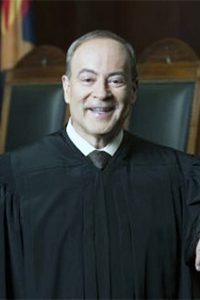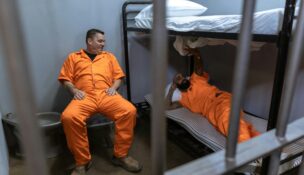Justice explains why she won’t recuse herself from retention case
ggrado//August 18, 2024//
She says she can’t speak for anyone else on the Supreme Court.
But Chief Justice Ann Scott Timmer told Capitol Media Services there’s a good reason she hasn’t recused herself from a case the court is expected to decide this week that could affect whether she and her colleagues must face voters again. She said any impact on her if the court allows Proposition 137 to go forward is “rather attenuated and speculative.”
Timmer is not alone in deciding she is capable of deciding whether what’s in the measure referred to the ballot by Republican lawmakers is legal.
Only two justices have stepped away: Clint Bolick and Kathryn King.
In their case, however, there is no question that the measure, if approved in November, would immediately shield them from being removed from the bench, even if voters decide they should be ousted.

That’s because, as crafted, it would retroactively override the public vote on their future. In fact, as written, the results of any vote to retain or reject them would not even be officially recorded.
But its effects, if allowed by the court to go to the ballot and approved by voters, would affect all the sitting justices if they decide they want to continue to serve beyond the end of their current terms.
And whether it makes the ballot in the first place will be decided by members of the high court this week, though only Timmer would comment about her decision not to step aside.
At its heart, the measure would override part of the system approved by voters in 1974 dealing with the selection and retention of Supreme Court justices and judges on the Court of Appeals and the superior courts in Pima, Pinal, Maricopa and Coconino counties.
All are selected by the governor who must pick from lists submitted by special screening panels. Nothing in Prop 137 would change that.
But what disappears is the ability of voters to decide on a regular basis, which is every four years for trial judges and every six for appellate-level judges, whether they should keep their jobs.

Replacing it would be a system where only judges who get into trouble through things like a personal bankruptcy, a felony conviction or a less-than-adequate rating from the Commission on Judicial Performance Review would have their futures decided by voters. Everyone else could serve until the mandatory retirement age of 70.
Supporters argue that the change makes sense because most voters are unfamiliar with what could be dozens of judges whose names appear on the ballot.
There’s also the argument that it shields judges from being targeted simply because voters don’t like one or more of their rulings. That’s clearly the case this year with Progress Arizona leading an effort to oust Bolick and King because they provided two of the four votes earlier this year to uphold the enforceability of the state’s 1864 law outlawing abortions except to save the life of the mother.
The issue of whether the measure can go on the ballot is before the justices because another provision in Prop 137 would, for the first time ever, allow lawmakers from the majority party to make appointments to the Commission on Judicial Performance Review and require the panel to investigate any legislatively generated allegations of malfeasance.
Challengers say that is an entirely different issue that cannot legally be packaged in an all-or-nothing offering for voters.
So sensitive was this issue when the lawsuit was filed that Maricopa County Superior Court Judge Randall Warner, who first got the case, recused himself. It ended up being assigned to Yavapai County Superior Court Judge John Napper, who is directly elected, not part of the retain-reject system, and would be unaffected by Prop 137.
Napper, a Republican, rejected the challenge, concluding both provisions are sufficiently related to each other to comply with requirements that constitutional amendments like this one can deal with only one subject. That sent the case to the Supreme Court where Bolick and King immediately recused themselves.
In the interview, the chief justice acknowledged there is no bright line on the question of when someone should step aside.
“This is a gray area,” she said. “People can make different calls, as the judge in Maricopa County did.”
And it comes down, Timmer said, to whether someone who is reasonable, looking at the case and the objective fact, might conclude there is at least an appearance that a particular judge couldn’t be fair.
“I concluded ‘no,’ ” she said.
Timmer said she knows there’s a line that determines whether a justice should step away from hearing a case. In fact, she said, she found herself on the other side of the line years ago.
That’s when there was a challenge to changes made by state lawmakers to the pension system for judges.
“That was really what I consider to be a more direct conflict,” Timmer said. “If the challengers in that case had prevailed, then the justices, myself included, would have gotten refunded a bunch of money as well as not having to pay as much in future pension contributions.”
And that, she said, involved real and immediate dollars.
“At the time I needed a new roof,” Timmer said.
“My thinking was ‘That’s a lot of money to get back and would pay for that,’ ” she continued. “So for me, it really wasn’t a question of an appearance of impropriety. It was an actual direct conflict.”
Timmer said that she would like to think that she could put her own needs, and the effects of a ruling on the pension changes, aside and simply judge the issue on its merits. But she said she couldn’t guarantee to herself that it wouldn’t be in the back of her mind.
“So, to me, that was a no-brainer,” Timmer said.
She wasn’t alone. All the other justices on the court at that time also recused themselves and were replaced by other judges from lower courts who had no financial stake in the outcome. The sole sitting justice who remained was Bolick who was not part of the pension system.
The pending case, she said, is different, at least for her, because there is no direct and immediate impact on her.
“People say, oh, it has a lot of benefits for judges and justices who stand for retention,” Timmer said of Prop 137.
“And that may be so,” she said. But Timmer said there are others who say there are drawbacks for those sitting on the bench.
“That’s really one of subjective analysis and one of policy that this court is not going to weigh in on,” she said. What the court has to decide is whether there are legal reasons not to allow voters to make that choice.
Still, in making that decision, the justices would determine whether voters will be allowed to make the change that could give her and her colleagues life terms. Timmer, however, said she doesn’t see it as affecting some protected interest the justices have in their jobs.
“There’s a lot of ‘ifs’ in there on what may or may not occur,” she said.
“It may not even occur that I stand for retention,” Timmer said, whose current term is up in 2028. And she said she already has enough years on the bench to qualify for the pension.
“I think that is too attenuated in my mind to make for a conflict of interest.”












































